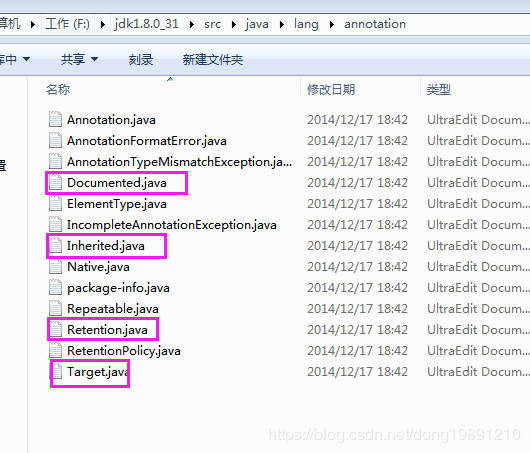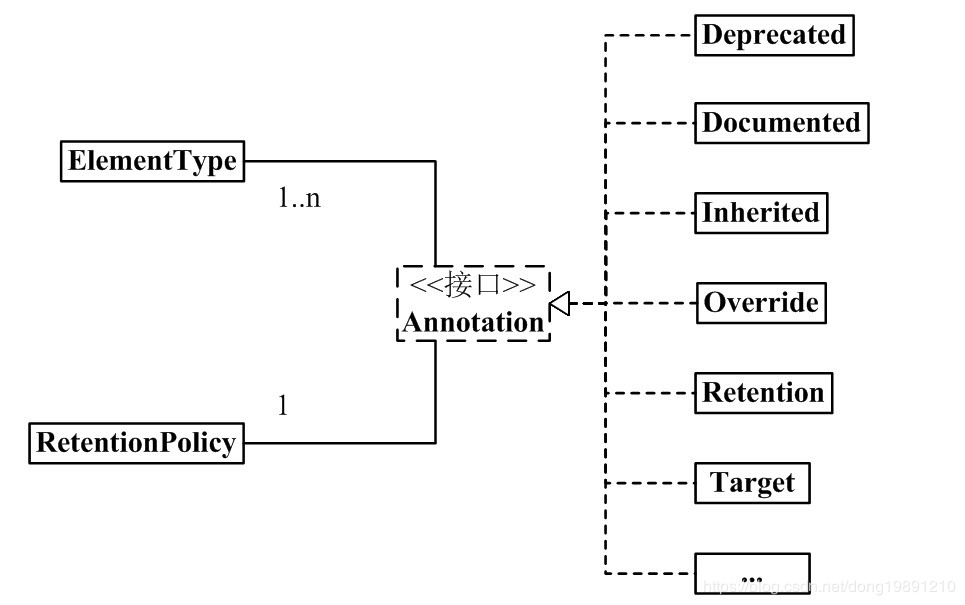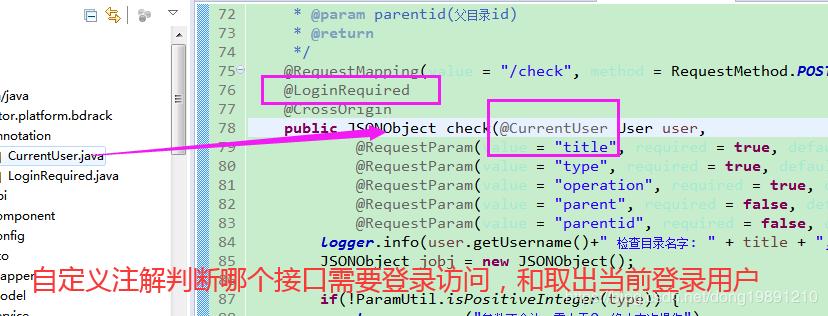Java 注解
2020-05-25 16:06:39来源:博客园 阅读 ()

Java 注解
元信息
Java 注解(Annotation)又称 Java 标注,是 JDK5.0 引入的一种注释机制。
Java 语言中的类、方法、变量、参数和包等都可以被标注。和 Javadoc 不同,Java 标注可以通过反射获取标注内容。在编译器生成类文件时,标注可以被嵌入到字节码中。Java 虚拟机可以保留标注内容,在运行时可以获取到标注内容 。 当然它也支持自定义 Java 标注。
由于jdk和框架大量使用注解,我也简单介绍下注解为何物,若您发现文章中存在错误或不足的地方,希望您能指出!
Java 定义了一套注解,共有 7 个,3 个在 java.lang 中,剩下 4 个在 java.lang.annotation 中。
作用在代码的注解是
- @Override - 检查该方法是否是重写方法。如果发现其父类,或者是引用的接口中并没有该方法时,会报编译错误。
- @Deprecated - 标记过时方法。如果使用该方法,会报编译警告。
- @SuppressWarnings - 指示编译器去忽略注解中声明的警告。
作用在其他注解的注解(或者说 元注解)是:
- @Retention - 标识这个注解怎么保存,是只在代码中,还是编入class文件中,或者是在运行时可以通过反射访问。
- @Documented - 标记这些注解是否包含在用户文档中。
- @Target - 标记这个注解应该是哪种 Java 成员。
- @Inherited - 标记这个注解是继承于哪个注解类(默认 注解并没有继承于任何子类)
从 Java 7 开始,额外添加了 3 个注解:
- @SafeVarargs - Java 7 开始支持,忽略任何使用参数为泛型变量的方法或构造函数调用产生的警告。
- @FunctionalInterface - Java 8 开始支持,标识一个匿名函数或函数式接口。
- @Repeatable - Java 8 开始支持,标识某注解可以在同一个声明上使用多次。
Annotation 架构图如下:
Annotation 的每一个实现类,都 和 1 个 RetentionPolicy 关联, 和 1~n 个 ElementType 关联。
注意RetentionPolicy的三种策略,自定义注解需要设置策略
public enum RetentionPolicy {
/**
* Annotations are to be discarded by the compiler.
注解将被编译器丢弃
*/
SOURCE,
/**
* Annotations are to be recorded in the class file by the compiler
* but need not be retained by the VM at run time. This is the default
* behavior.
注解在class文件中可用,但会被VM丢弃
*/
CLASS,
/**
* Annotations are to be recorded in the class file by the compiler and
* retained by the VM at run time, so they may be read reflectively.
* VM将在运行期也保留注释,因此可以通过反射机制读取注解的信息
* @see java.lang.reflect.AnnotatedElement
*/
RUNTIME
}注意ElementType,自定义注解时特别关注,有多种类型
public enum ElementType {
/** Class, interface (including annotation type), or enum declaration
类,接口(包括注解类型)或enum声明*/
TYPE,
/** Field declaration (includes enum constants)
域声明(包括 enum 实例)*/
FIELD,
/** Method declaration 方法声明*/
METHOD,
/** Formal parameter declaration 参数声明*/
PARAMETER,
/** Constructor declaration 构造器声明*/
CONSTRUCTOR,
/** Local variable declaration 局部变量声明*/
LOCAL_VARIABLE,
/** Annotation type declaration 注解类型声明*/
ANNOTATION_TYPE,
/** Package declaration 包声明*/
PACKAGE,
/**
* Type parameter declaration
*
* @since 1.8
*/
TYPE_PARAMETER,
/**
* Use of a type
*
* @since 1.8
*/
TYPE_USE
}
下面是个小例子:
自定义注解:
@Documented
@Target({ElementType.TYPE, ElementType.CONSTRUCTOR, ElementType.FIELD, ElementType.METHOD, ElementType.PARAMETER})
@Inherited
@Retention(RetentionPolicy.RUNTIME)
public @interface CustomAnnotation {
public String name() default "";
public String value() default "";
}
在类中使用
/**
* @author dgm
* @describe ""
*/
@CustomAnnotation(name="Class Annotation", value = " 类上的注解")
public class SampleClass {
@CustomAnnotation(name = "field Annotation", value = "字段上的注解")
public String sampleField;
@CustomAnnotation(name = "constructor Annotation", value = "构造器上的注解")
public SampleClass(String sampleField) {
super();
this.sampleField = sampleField;
}
@CustomAnnotation(name = "Method Annotation getSampleField", value = "getSampleField无参方法上的注解")
public String getSampleField() {
System.out.println("getSampleField");
return sampleField;
}
@CustomAnnotation(name = "Method Annotation setSampleField", value = "setSampleField方法上的注解")
public void setSampleField(String sampleField) {
System.out.println("setSampleField=" + sampleField);
this.sampleField = sampleField;
}
@CustomAnnotation(name = "Method Annotation getSampleField hava param", value = "getSampleField有参方法上的注解")
private String getSampleField(String sampleField) {
return sampleField;
}
}测试类
/**
*
* @author dgm
* @describe ""
*/
public class CustomAnnotationTest {
public static void main(String[] args) throws ClassNotFoundException, InstantiationException, IllegalAccessException, IllegalArgumentException, InvocationTargetException {
Class c0 = SampleClass.class;
Class c1 = Class.forName("spring.annotation.SampleClass");
Object o = null;
try {
o = Class.forName("spring.annotation.SampleClass").getConstructor(String.class).newInstance("dongguangming");
} catch (NoSuchMethodException | SecurityException e) {
// TODO Auto-generated catch block
e.printStackTrace();
}
Class c2 = o.getClass();
System.out.println(c0 == c1);
System.out.println(c0 == c2);
System.out.println(c1 == c2);
// 获取类的所有注解
Annotation[] classAnnotation = c0.getAnnotations();
for (Annotation ca : classAnnotation) {
if (ca instanceof CustomAnnotation) {
CustomAnnotation customAnnotation = (CustomAnnotation) ca;
System.out.println("class name: " + customAnnotation.name());
System.out.println("class value: " + customAnnotation.value());
}
}
// 获取类的公有field
Field[] fields = c0.getFields();
for (Field field : fields) {
Annotation[] fieldAnnotation = field.getAnnotations();
for (Annotation fa : fieldAnnotation) {
if (fa instanceof CustomAnnotation) {
CustomAnnotation customAnnotation = (CustomAnnotation) fa;
System.out
.println("field name: " + customAnnotation.name());
System.out.println("field value: "
+ customAnnotation.value());
}
}
}
// 获取构造器的所有注解
// 获取类的构造器
Constructor<?>[] publicConstructors = c0.getConstructors();//getDeclaredConstructors
for (Constructor constructor : publicConstructors) {
Annotation[] methodAnnotation = constructor.getAnnotations();
for (Annotation ma : methodAnnotation) {
if (ma instanceof CustomAnnotation) {
CustomAnnotation customAnnotation = (CustomAnnotation) ma;
System.out.println("构造器 name: "
+ customAnnotation.name());
System.out.println("构造器 value: "
+ customAnnotation.value());
}
}
}
// 获取类的公有方法
Method[] methods = c0.getMethods();
// Annotation annotation =
// methods[1].getAnnotation(CustomAnnotation.class);
for (Method method : methods) {
Annotation[] methodAnnotation = method.getAnnotations();
for (Annotation ma : methodAnnotation) {
if (ma instanceof CustomAnnotation) {
CustomAnnotation customAnnotation = (CustomAnnotation) ma;
System.out.println("method name: "
+ customAnnotation.name());
System.out.println("method value: "
+ customAnnotation.value());
}
}
// 获取方法上的所有参数注解
Annotation[][] parameterAnnotations = method.getParameterAnnotations();
for(Annotation[] pa : parameterAnnotations){
for(Annotation a:pa){
if(a instanceof CustomAnnotation){
System.out.println("method param name: "
+ ((CustomAnnotation) a).name());
System.out.println("method param value: "
+ ((CustomAnnotation) a).value());
}
}
}
}
}
}执行效果:
看到了吧,一个类上可以多个注解,一个字段也可以有多个注解,构造器上也可以多个注解,方法上也可以有多个注解、参数上也可以有多个注解,而类是可以有多个字段、多个构造器(每个构造器都可能有多个参数)、多个方法(每个方法也都肯能有多个参数)),所以真正写框架时光逻辑性if else判断就折腾 了。。。举个例子类上有A注解执行什么代码,有B注解执行什么代码,以此类推字段、构造器、方法、参数的多个注解的处理过程。
实际开发中我们也会用到自定义注解,比如:
自定义注解是很强大的功能,广泛应用于框架(Struts,hibernate,Mybatis,Spring, Spring boot,sping cloud,dubbo等)和系统开发公共模块(比如上图中的登录拦截和取当前用户)中
参考:
0. Java程序员必须掌握的5个注解! https://developer.51cto.com/art/201807/577539.htm
1. Lesson: Annotations
https://docs.oracle.com/javase/tutorial/java/annotations/
2. Java Annotations Tutorial https://www.javacodegeeks.com/2014/11/java-annotations-tutorial.html
3. How To Process Java Annotations
https://www.javacodegeeks.com/2015/01/how-to-process-java-annotations.html
4. An introductory guide to annotations and annotation processors
https://blog.frankel.ch/introductory-guide-annotation-processor/
5. Java Annotation Processing and Creating a Builder
https://www.baeldung.com/java-annotation-processing-builder
6. How and when to use Enums and Annotations https://www.javacodegeeks.com/2015/09/how-and-when-to-use-enums-and-annotations.html
7. Common Annotations for the Java™ Platform™ https://download.oracle.com/otn-pub/jcp/common_annotations-1_3-mrel3-eval-spec/jsr-250.pdf?AuthParam=1590270326_b56b01b1aeacddec8562720c1b2f27b8
8. Java - Understanding @Inherited meta annotation
https://www.logicbig.com/tutorials/core-java-tutorial/annotations/inherited-meta-annotation.html
9. 深入理解java注解的实现原理 https://mp.weixin.qq.com/s?__biz=MzAxMjY1NTIxNA==&mid=2454441897&idx=1&sn=729688d470c94560c1e73e79f0c13adc&chksm=8c11e0a8bb6669be1cc4daee95b221ba437d536d598520d635fac4f18612dded58d6fddb0dce&scene=21#wechat_redirect
原文链接:https://www.cnblogs.com/dongguangming/p/12953801.html
如有疑问请与原作者联系
标签:
版权申明:本站文章部分自网络,如有侵权,请联系:west999com@outlook.com
特别注意:本站所有转载文章言论不代表本站观点,本站所提供的摄影照片,插画,设计作品,如需使用,请与原作者联系,版权归原作者所有
- 国外程序员整理的Java资源大全(全部是干货) 2020-06-12
- 2020年深圳中国平安各部门Java中级面试真题合集(附答案) 2020-06-11
- 2020年java就业前景 2020-06-11
- 04.Java基础语法 2020-06-11
- Java--反射(框架设计的灵魂)案例 2020-06-11
IDC资讯: 主机资讯 注册资讯 托管资讯 vps资讯 网站建设
网站运营: 建站经验 策划盈利 搜索优化 网站推广 免费资源
网络编程: Asp.Net编程 Asp编程 Php编程 Xml编程 Access Mssql Mysql 其它
服务器技术: Web服务器 Ftp服务器 Mail服务器 Dns服务器 安全防护
软件技巧: 其它软件 Word Excel Powerpoint Ghost Vista QQ空间 QQ FlashGet 迅雷
网页制作: FrontPages Dreamweaver Javascript css photoshop fireworks Flash




